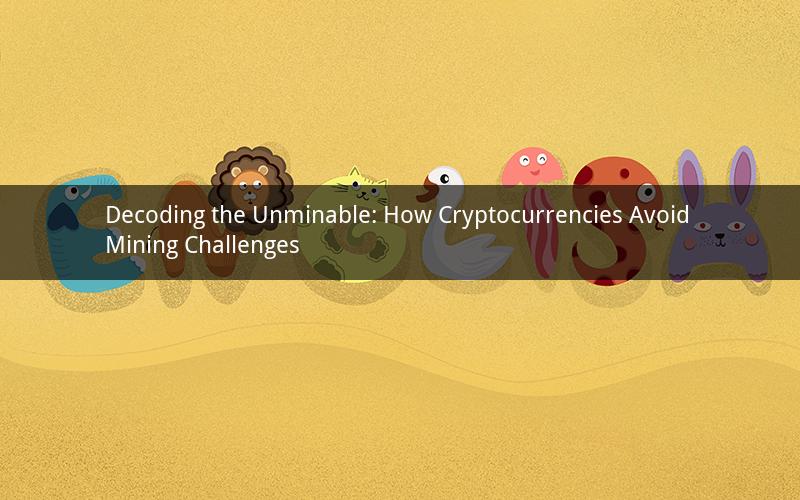
Cryptocurrencies have revolutionized the financial landscape, but not all cryptocurrencies are subject to the mining process. The concept of unminable cryptocurrencies might seem counterintuitive, given the mining's crucial role in maintaining the blockchain's integrity. This article delves into how these digital currencies bypass mining, their unique characteristics, and their potential impact on the future of blockchain technology.
1. The Basics of Cryptocurrency Mining
Cryptocurrency mining is a process that involves using computers to solve complex mathematical puzzles. These puzzles validate transactions on the blockchain, ensuring the network's security and maintaining its decentralized nature. Miners are rewarded with new cryptocurrency tokens for their computational efforts.
2. The Problem with Traditional Mining
Despite its effectiveness, traditional mining presents several challenges. The most pressing issues include:
a. Energy Consumption: Mining requires significant computational power, leading to substantial energy consumption and environmental concerns.
b. Centralization: Large mining operations can accumulate significant power, potentially leading to centralization and reducing the network's decentralization.
c. Accessibility: The barriers to entry for mining can be high, as it requires expensive equipment and technical expertise.
3. Unminable Cryptocurrencies: A New Approach
Unminable cryptocurrencies represent a new direction in the world of digital currencies. These currencies avoid traditional mining by utilizing alternative mechanisms to ensure their security and maintain their decentralized nature. Here's how some of these mechanisms work:
a. Proof of Stake (PoS): In PoS, validators are chosen to create new blocks based on the amount of cryptocurrency they hold and are willing to "stake" as collateral. This approach reduces energy consumption and centralization concerns compared to traditional mining.
b. Proof of Authority (PoA): PoA involves a predefined set of validators who are trusted to create new blocks. This mechanism aims to improve scalability and reduce energy consumption.
c. Delegated Proof of Stake (DPoS): DPoS is a variant of PoS, where token holders vote for delegates to represent them in the consensus process. This system aims to provide a balance between decentralization and scalability.
4. Unique Characteristics of Unminable Cryptocurrencies
Unminable cryptocurrencies exhibit several unique characteristics:
a. Lower Energy Consumption: As these currencies avoid traditional mining, they consume significantly less energy, making them more environmentally friendly.
b. Increased Scalability: Unminable cryptocurrencies often offer improved scalability due to the absence of mining, allowing for faster transaction processing times.
c. Reduced Centralization: By utilizing alternative consensus mechanisms, unminable cryptocurrencies aim to maintain a decentralized network, reducing the risk of centralization.
5. The Potential Impact on Blockchain Technology
The rise of unminable cryptocurrencies has the potential to significantly impact blockchain technology. Here are a few potential outcomes:
a. Environmental Benefits: By reducing energy consumption, unminable cryptocurrencies can help mitigate the environmental impact of blockchain technology.
b. Increased Accessibility: With lower energy and technical barriers, unminable cryptocurrencies can become more accessible to a wider audience.
c. Innovation: The exploration of alternative consensus mechanisms can lead to further innovation in blockchain technology.
Frequently Asked Questions:
1. What is the main advantage of unminable cryptocurrencies over traditional mining?
Answer: The main advantage of unminable cryptocurrencies is their lower energy consumption and reduced centralization risks compared to traditional mining.
2. Can unminable cryptocurrencies still ensure network security?
Answer: Yes, unminable cryptocurrencies can still ensure network security by utilizing alternative consensus mechanisms such as PoS, PoA, and DPoS.
3. Are unminable cryptocurrencies more environmentally friendly than traditional mining cryptocurrencies?
Answer: Yes, unminable cryptocurrencies are generally more environmentally friendly due to their lower energy consumption.
4. Will unminable cryptocurrencies replace traditional mining cryptocurrencies?
Answer: It is unlikely that unminable cryptocurrencies will completely replace traditional mining cryptocurrencies. However, they are expected to play an increasingly significant role in the future of blockchain technology.
5. Can unminable cryptocurrencies achieve the same level of decentralization as traditional mining cryptocurrencies?
Answer: While unminable cryptocurrencies aim to maintain decentralization, the level of decentralization may vary depending on the specific consensus mechanism used. Some unminable cryptocurrencies may achieve a similar level of decentralization as traditional mining cryptocurrencies.